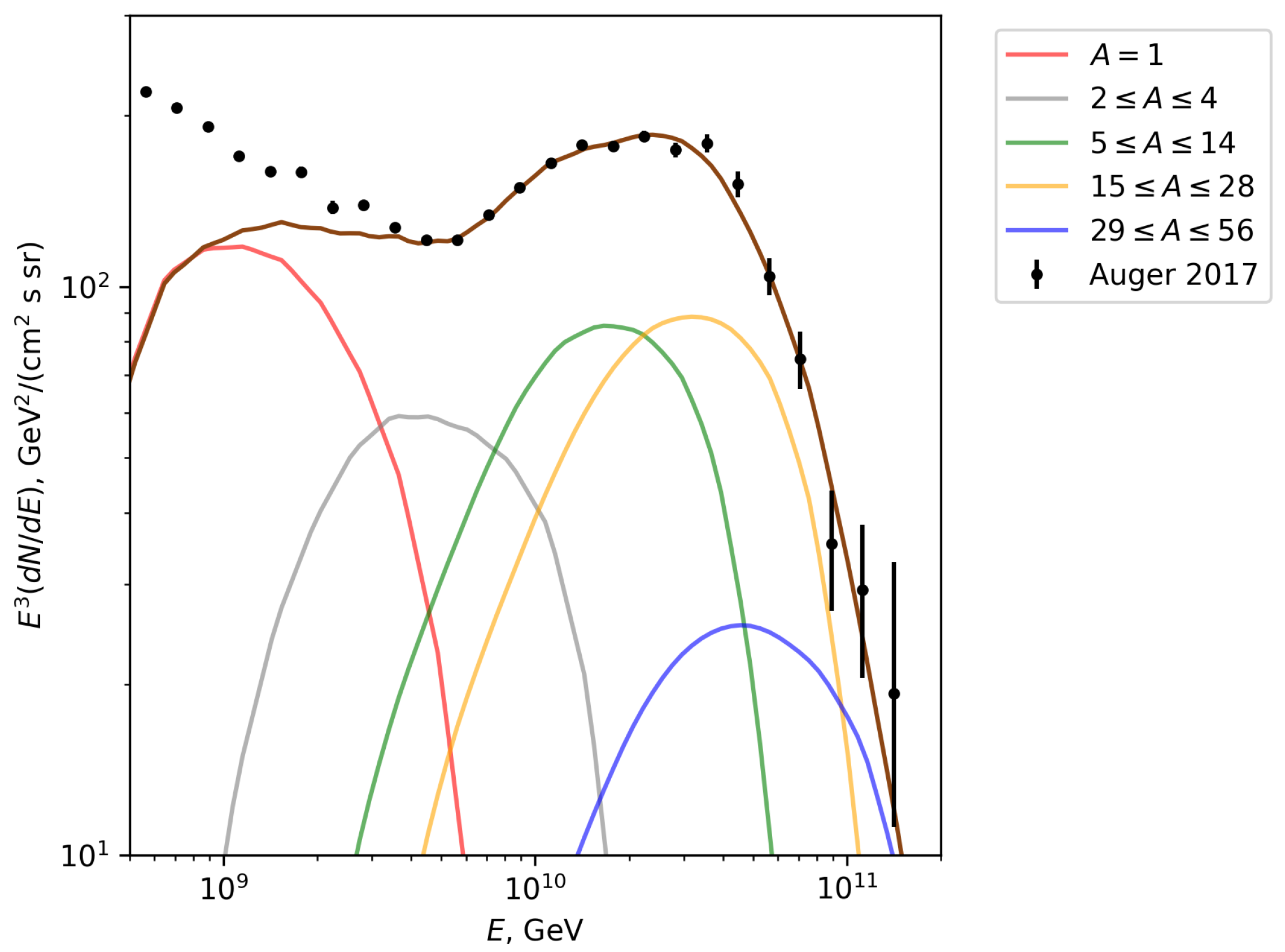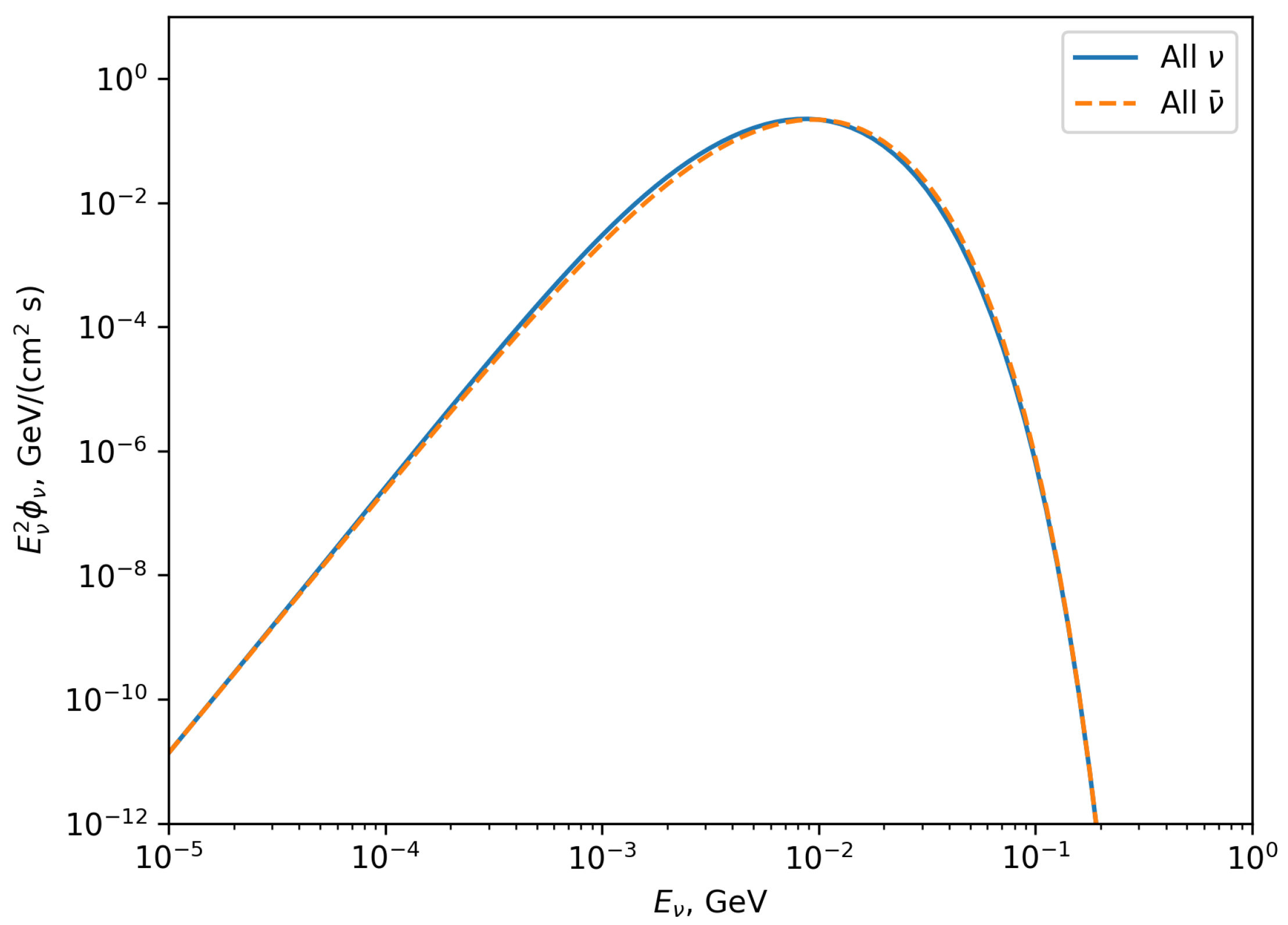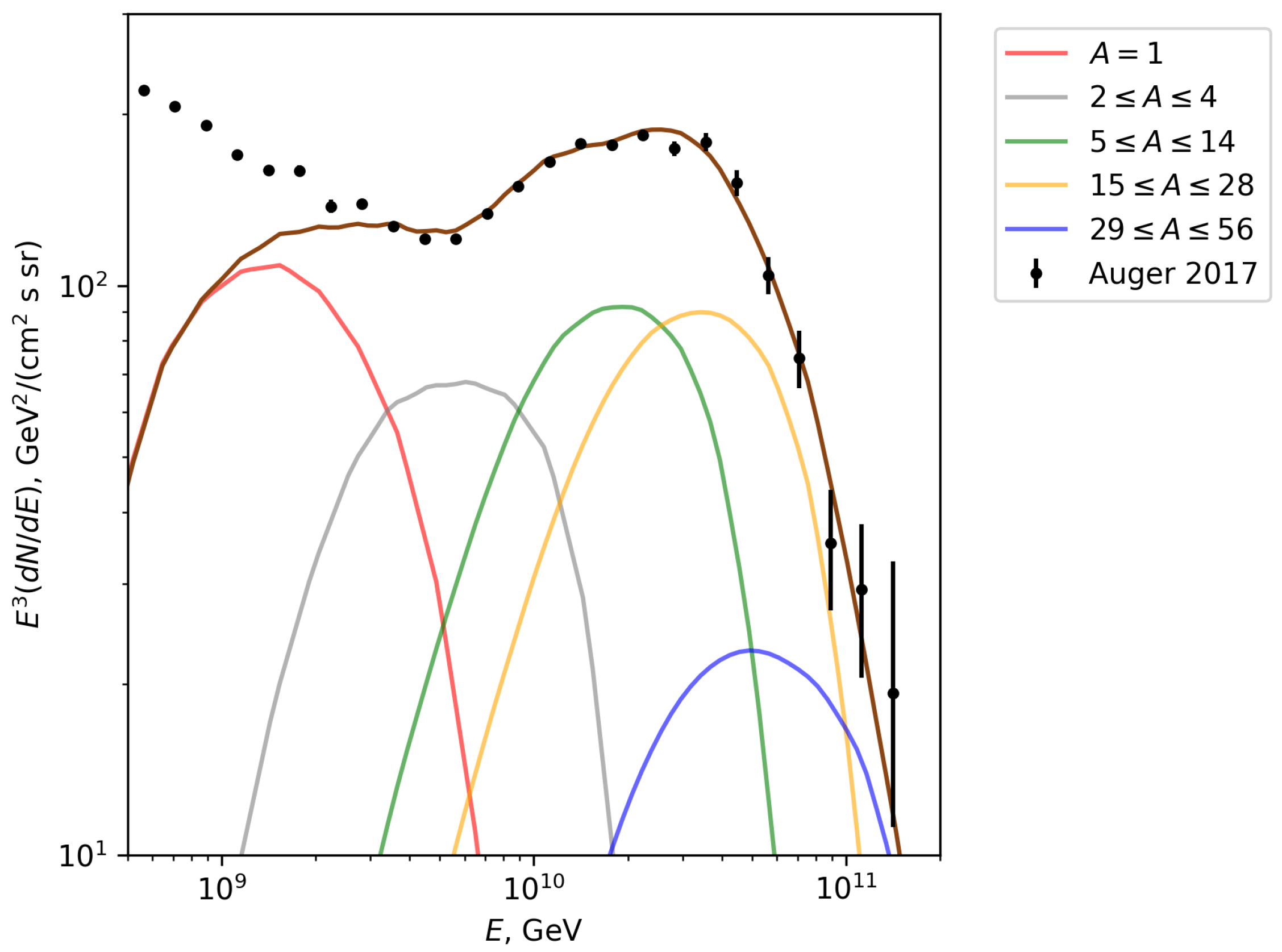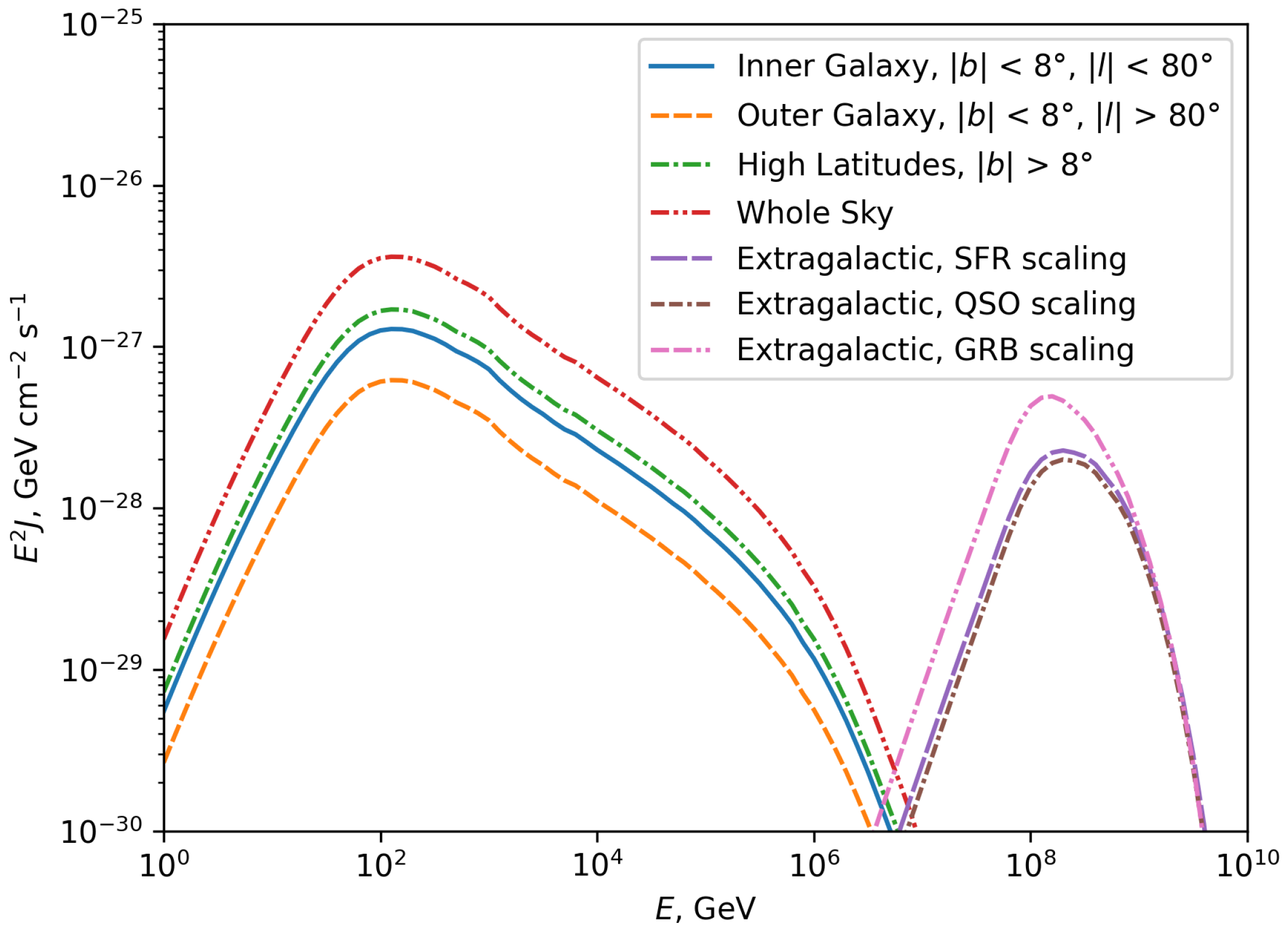Cosmic-Ray Boosted Diffuse Supernova Neutrinos
Abstract
1. Introduction
2. Diffuse Supernova Neutrino Background
3. Cosmic Ray Flux
3.1. Galactic Cosmic Ray Flux
3.2. Extragalactic Cosmic Ray Flux
4. Neutrino–Nucleon and Neutrino–Nucleus Scattering Cross-Sections
5. Galactic-Boosted Neutrino Flux
5.1. Elastic Scattering
5.2. Deep Inelastic Scattering
5.3. Local Neutrino Emission Rate
5.4. Intensity of Boosted Neutrinos from Galactic Cosmic Rays
5.5. Intensity of Boosted Neutrinos from Extragalactic Cosmic Rays
6. Conclusions
Funding
Data Availability Statement
Acknowledgments
Conflicts of Interest
Appendix A. Form Factors for the Elastic Neutrino–Nucleon Cross-Section According to [21]


References
- Abe, K.; Bronner, C.; Hayato, Y.; Hiraide, K.; Ikeda, M.; Imaizumi, S.; Kameda, J.; Kanemura, Y.; Kataoka, Y.; Miki, S.; et al. Diffuse supernova neutrino background search at Super-Kamiokande. Phys. Rev. D 2021, 104, 122002. [Google Scholar] [CrossRef]
- Abusleme, A.; Adam, T.; Ahmad, S.; Ahmed, R.; Aiello, S.; Akram, M.; An, F.; An, Q.; Andronico, G.; Anfimov, N.; et al. Prospects for detecting the diffuse supernova neutrino background with JUNO. J. Cosmol. Astropart. Phys. 2022, 2022, 033. [Google Scholar] [CrossRef]
- Zhang, J.; Sandrock, A.; Liao, J.; Yue, B. Impact of coherent scattering on relic neutrinos boosted by cosmic rays. arXiv 2025, arXiv:2505.04791. [Google Scholar] [CrossRef]
- Marchi, A.G.D.; Granelli, A.; Nava, J.; Sala, F. Relic neutrino background from cosmic-ray reservoirs. Phys. Rev. D 2025, 111, 023023. [Google Scholar] [CrossRef]
- Schwefer, G.; Mertsch, P.; Wiebusch, C. Diffuse Emission of Galactic High-energy Neutrinos from a Global Fit of Cosmic Rays. Astrophys. J. 2023, 949, 16. [Google Scholar] [CrossRef]
- Bérat, C.; Condorelli, A.; Deligny, O.; Montanet, F.; Torrès, Z. Floor of Cosmogenic Neutrino Fluxes above 1017 eV. Astrophys. J. 2024, 966, 186. [Google Scholar] [CrossRef]
- Abbasi, R.; Ackermann, M.; Adams, J.; Agarwalla, S.K.; Aguilar, J.A.; Ahlers, M.; Alameddine, J.M.; Amin, N.M.; Andeen, K.; Argüelles, C.; et al. Search for Extremely-High-Energy Neutrinos and First Constraints on the Ultrahigh-Energy Cosmic-Ray Proton Fraction with IceCube. Phys. Rev. Lett. 2025, 135, 031001. [Google Scholar] [CrossRef] [PubMed]
- Meier, M. Recent cosmogenic neutrino search results with IceCube and prospects with IceCube-Gen2. In Proceedings of the 58th Rencontres de Moriond, Very High Energy Phenomena in the Universe, La Thuile, Italy, 24–31 March 2024; Available online: https://inspirehep.net/literature/2824868 (accessed on 2 September 2025).
- Aab, A.; Abreu, P.; Aglietta, M.; Albuquerque, I.; Albury, J.; Allekotte, I.; Almela, A.; Castillo, J.A.; Alvarez-Muñiz, J.; Anastasi, G.; et al. Probing the origin of ultra-high-energy cosmic rays with neutrinos in the EeV energy range using the Pierre Auger Observatory. J. Cosmol. Astropart. Phys. 2019, 10, 022. [Google Scholar] [CrossRef]
- Iváñez Ballesteros, P.; Volpe, M.C. Neutrino nonradiative decay and the diffuse supernova neutrino background. Phys. Rev. D 2023, 107, 023017. [Google Scholar] [CrossRef]
- Keil, M.T.; Raffelt, G.G.; Janka, H.T. Monte Carlo Study of Supernova Neutrino Spectra Formation. Astrophys. J. 2003, 590, 971. [Google Scholar] [CrossRef]
- Gaisser, T.K. Spectrum of cosmic-ray nucleons and the atmospheric muon charge ratio. Astropart. Phys. 2012, 35, 801. [Google Scholar] [CrossRef]
- Maurin, D.; Ahlers, M.; Dembinski, H.; Haungs, A.; Mangeard, P.S.; Melot, F.; Mertsch, P.; Wochele, D.; Wochele, J. A cosmic-ray database update: CRDB v4.1. Eur. Phys. J. C 2023, 83, 971. [Google Scholar] [CrossRef]
- Evoli, C. The Cosmic-Ray Energy Spectrum. 2020. Available online: https://github.com/carmeloevoli/The_CR_Spectrum (accessed on 25 July 2025). [CrossRef]
- Heinze, J.; Fedynitch, A.; Boncioli, D.; Winter, W. A New View on Auger Data and Cosmogenic Neutrinos in Light of Different Nuclear Disintegration and Air-shower Models. Ap. J. 2019, 873, 88. [Google Scholar] [CrossRef]
- Hopkins, A.M.; Beacom, J.F. On the Normalization of the Cosmic Star Formation History. Ap. J. 2006, 651, 142. [Google Scholar] [CrossRef]
- Wall, J.V.; Jackson, C.A.; Shaver, P.A.; Hook, I.M.; Kellermann, K.I. The Parkes quarter-Jansky flat-spectrum sample: III. Space density and evolution of QSOs. Astron. Astrophys. 2005, 434, 133. [Google Scholar] [CrossRef]
- Aab, A.; Abreu, P.; Aglietta, M.; Al Samarai, I.; Albuquerque, I.; Allekotte, I.; Almela, A.; Castillo, J.A.; Alvarez-Muñiz, J.; Anastasi, G.; et al. Combined fit of spectrum and composition data as measured by the Pierre Auger Observatory. J. Cosmol. Astropart. Phys. 2017, 2017, 038. [Google Scholar] [CrossRef]
- Verzi, V. Measurement of the energy spectrum of ultra-high energy cosmic rays using the Pierre Auger Observatory. In Proceedings of the 36th International Cosmic Ray Conference (ICRC2019), Madison, WI, USA, 24 July–1 August 2019; Proceedings of Science. Volume 358, p. 450. [Google Scholar]
- Koning, A.J.; Hilaire, S.; Duijvestijn, M.C. TALYS: Comprehensive Nuclear Reaction Modeling. In Proceedings of the International Conference on Nuclear Data for Science and Technology, Santa Fe, NM, USA, 26 September–1 October 2004; AIP Conference Proceedings. Volume 769, p. 1154. [Google Scholar]
- Ahrens, L.A.; Aronson, S.H.; Connolly, P.L.; Gibbard, B.G.; Murtagh, M.J.; Murtagh, S.J.; Terada, S.; White, D.H.; Callas, J.L.; Cutts, D.; et al. Measurement of neutrino-proton and antineutrino-proton elastic scattering. Phys. Rev. D 1987, 35, 785. [Google Scholar] [CrossRef]
- Mandelstam, S. Determination of the Pion-Nucleon Scattering Amplitude from Dispersion Relations and Unitarity. General Theory. Phys. Rev. 1958, 112, 1344–1360. [Google Scholar] [CrossRef]
- Formaggio, J.A.; Zeller, G.P. From eV to EeV: Neutrino cross sections across energy scales. Rev. Mod. Phys. 2012, 84, 1307. [Google Scholar] [CrossRef]
- Klein, S.R.; Nystrand, J. Exclusive vector meson production in relativistic heavy ion collisions. Phys. Rev. C 1999, 60, 014903. [Google Scholar] [CrossRef]
- Block, M.M.; Durand, L.; Ha, P. Connection of the virtual γ*p cross section of ep deep inelastic scattering to real γp scattering, and the implications for νN and ep total cross sections. Phys. Rev. D 2014, 89, 094027. [Google Scholar] [CrossRef]
- Abe, K.; Akagi, T.; Anthony, P.L.; Antonov, R.; Arnold, R.G.; Averett, T.; Band, H.R.; Bauer, J.M.; Borel, H.; Bosted, P.E.; et al. Measurements of R = σL/σT for 0.03 < x < 0.1 and fit to world data. Phys. Lett. B 1999, 452, 194. [Google Scholar]
- Lipari, P.; Vernetto, S. Diffuse Galactic gamma ray flux at very high energy. Phys. Rev. D 2018, 98, 043003. [Google Scholar] [CrossRef]
- Lang, G.X.; Wei, J.J.; Zeng, H.D.; Li, Y.; Wu, X.F. Revisiting the luminosity and redshift distributions of long gamma-ray bursts. Mon. Not. Roy. Astron. Soc. 2021, 508, 52. [Google Scholar]
- Gilmore, R.C.; Somerville, R.S.; Primack, J.R.; Domínguez, A. Semi-analytic modelling of the extragalactic background light and consequences for extragalactic gamma-ray spectra. Mon. Not. Roy. Astron. Soc. 2012, 422, 3189. [Google Scholar] [CrossRef]





| Source Density Scaling | Star Formation Rate | Quasar Rate | Gamma Ray Burst Rate |
|---|---|---|---|
| , | |||
| −0.8 | −1.0 | −0.8 | |
| , | 1.0 × 10 −45 | 2.2 × 10 −45 | 1.7 × 10 −46 |
| , | 4.5 × 10 −46 | 7.7 × 10 −46 | 4.6 × 10 −47 |
| , | 6.2 × 10 −47 | 6.1 × 10 −47 | 5.5 × 10 −47 |
| , | 4.1 × 10 −48 | 2.3 × 10 −48 | 3.9 × 10 −48 |
| , | 9.0 × 10 −50 | 6.6 × 10 −50 | 9.5 × 10 −50 |
Disclaimer/Publisher’s Note: The statements, opinions and data contained in all publications are solely those of the individual author(s) and contributor(s) and not of MDPI and/or the editor(s). MDPI and/or the editor(s) disclaim responsibility for any injury to people or property resulting from any ideas, methods, instructions or products referred to in the content. |
© 2025 by the author. Licensee MDPI, Basel, Switzerland. This article is an open access article distributed under the terms and conditions of the Creative Commons Attribution (CC BY) license (https://creativecommons.org/licenses/by/4.0/).
Share and Cite
Sandrock, A. Cosmic-Ray Boosted Diffuse Supernova Neutrinos. Astronomy 2025, 4, 17. https://doi.org/10.3390/astronomy4030017
Sandrock A. Cosmic-Ray Boosted Diffuse Supernova Neutrinos. Astronomy. 2025; 4(3):17. https://doi.org/10.3390/astronomy4030017
Chicago/Turabian StyleSandrock, Alexander. 2025. "Cosmic-Ray Boosted Diffuse Supernova Neutrinos" Astronomy 4, no. 3: 17. https://doi.org/10.3390/astronomy4030017
APA StyleSandrock, A. (2025). Cosmic-Ray Boosted Diffuse Supernova Neutrinos. Astronomy, 4(3), 17. https://doi.org/10.3390/astronomy4030017






